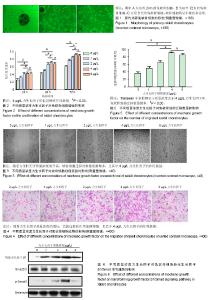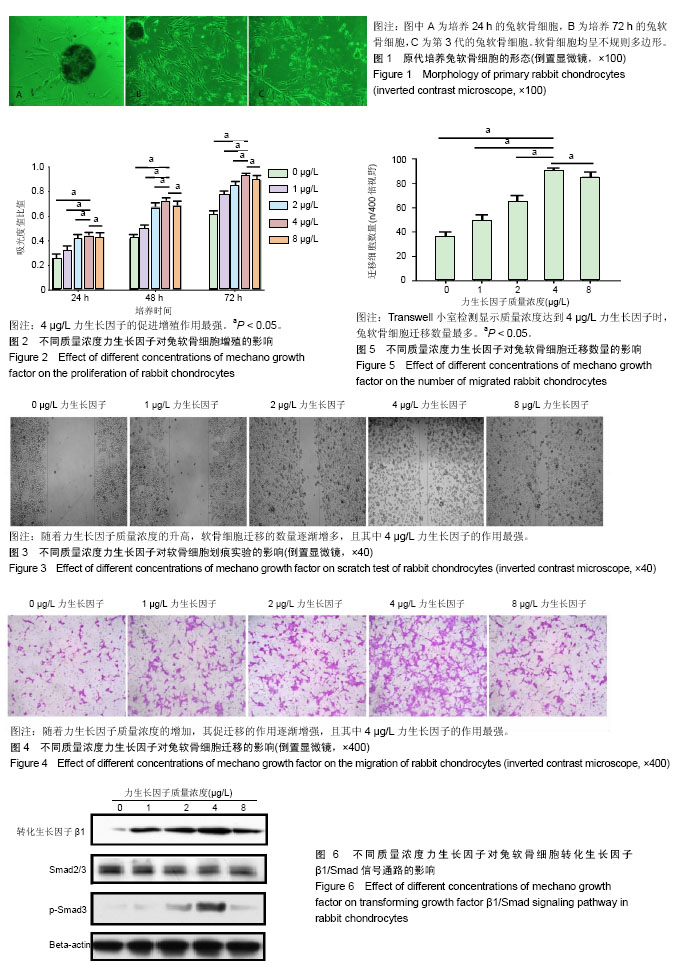| [1] Matheny RW Jr, Nindl BC, Adamo ML. Minireview: Mechano-growth factor: a putative product of IGF-I gene expression involved in tissue repair and regeneration. Endocrinology. 2010;151(3):865-875. [2] Philippou A, Maridaki M, Halapas A, et al. The role of the insulin-like growth factor 1 (IGF-1) in skeletal muscle physiology. In Vivo. 2007;21(1):45-54. [3] Goldspink G. Mechanical signals, IGF-I gene splicing, and muscle adaptation. Physiology (Bethesda). 2005;20: 232-238. [4] Varela-Eirin M, Loureiro J, Fonseca E, et al. Cartilage regeneration and ageing: Targeting cellular plasticity in osteoarthritis. Ageing Res Rev. 2018;42:56-71. [5] Loeser RF, Collins JA, Diekman BO. Ageing and the pathogenesis of osteoarthritis. Nat Rev Rheumatol. 2016; 12(7):412-420. [6] Kobayashi T, Fujita K, Kamatani T, et al. A-674563 increases chondrocyte marker expression in cultured chondrocytes by inhibiting Sox9 degradation. Biochem Biophys Res Commun. 2018;495(1):1468-1475. [7] Ma N, Wang H, Xu X, et al. Autologous-cell-derived, tissue-engineered cartilage for repairing articular cartilage lesions in the knee: study protocol for a randomized controlled trial. Trials. 2017;18(1):519. [8] Karaarslan N, Batmaz AG, Yilmaz I, et al. Effect of naproxen on proliferation and differentiation of primary cell cultures isolated from human cartilage tissue. Exp Ther Med. 2018; 16(3):1647-1654. [9] Chen JJ, Zhang W. High expression of WWP1 predicts poor prognosis and associates with tumor progression in human colorectal cancer. Am J Cancer Res. 2018;8(2):256-265. [10] David E, Tirode F, Baud'huin M, et al. Oncostatin M is a growth factor for Ewing sarcoma. Am J Pathol. 2012;181(5): 1782-1795. [11] Kung LH, Rajpar MH, Briggs MD, et al. Hypertrophic chondrocytes have a limited capacity to cope with increases in endoplasmic reticulum stress without triggering the unfolded protein response. J Histochem Cytochem. 2012; 60(10):734-748. [12] Peng C, Zhao H, Song Y, et al. SHCBP1 promotes synovial sarcoma cell metastasis via targeting TGF-β1/Smad signaling pathway and is associated with poor prognosis. J Exp Clin Cancer Res. 2017;36(1):141. [13] Zhao H, Peng C, Ruan G, et al. Adenovirus-delivered PDCD5 counteracts adriamycin resistance of osteosarcoma cells through enhancing apoptosis and inhibiting Pgp. Int J Clin Exp Med. 2014;7(12):5429-5436. [14] Armakolas A, Philippou A, Panteleakou Z, et al. Preferential expression of IGF-1Ec (MGF) transcript in cancerous tissues of human prostate: evidence for a novel and autonomous growth factor activity of MGF E peptide in human prostate cancer cells. Prostate. 2010;70(11):1233-1242. [15] Deng M, Zhang B, Wang K, et al. Mechano growth factor E peptide promotes osteoblasts proliferation and bone-defect healing in rabbits. Int Orthop. 2011;35(7):1099-1106. [16] Qin LL, Li XK, Xu J, et al. Mechano growth factor (MGF) promotes proliferation and inhibits differentiation of porcine satellite cells (PSCs) by down-regulation of key myogenic transcriptional factors. Mol Cell Biochem. 2012;370(1-2): 221-230. [17] 李元靖,刘欢,樊欣,等.MGF对人软骨终板干细胞增殖和迁移的影响[J].中国细胞生物学学报,2015,37(3):335-342.[18] Sha Y, Yang L, Lv Y. ERK1/2 and Akt phosphorylation were essential for MGF E peptide regulating cell morphology and mobility but not proangiogenic capacity of BMSCs under severe hypoxia. Cell Biochem Funct. 2018;36(3):155-165. [19] Zhang B, Luo Q, Sun J, et al. MGF enhances tenocyte invasion through MMP-2 activity via the FAK-ERK1/2 pathway. Wound Repair Regen. 2015;23(3):394-402. [20] Luo Z, Jiang L, Xu Y, et al. Mechano growth factor (MGF) and transforming growth factor (TGF)-β3 functionalized silk scaffolds enhance articular hyaline cartilage regeneration in rabbit model. Biomaterials. 2015;52:463-475. [21] Li C, Vu K, Hazelgrove K, et al. Increased IGF-IEc expression and mechano-growth factor production in intestinal muscle of fibrostenotic Crohn's disease and smooth muscle hypertrophy. Am J Physiol Gastrointest Liver Physiol. 2015;309(11): G888-899. [22] Jing X, Ye Y, Bao Y, et al. Mechano-growth factor protects against mechanical overload induced damage and promotes migration of growth plate chondrocytes through RhoA/YAP pathway. Exp Cell Res. 2018;366(2):81-91. [23] He J, Dong L, Xu K, et al. Mechano growth factor E peptide inhibits invasion of melanoma cells and up-regulates CHOP expression via endoplasmic reticulum stress. Biotechnol Lett. 2018;40(1):205-213. [24] Li H, Lei M, Yu C, et al. Mechano growth factor-E regulates apoptosis and inflammatory responses in fibroblast-like synoviocytes of knee osteoarthritis. Int Orthop. 2015;39(12): 2503-2509. [25] Tong Y, Feng W, Wu Y, et al. Mechano-growth factor accelerates the proliferation and osteogenic differentiation of rabbit mesenchymal stem cells through the PI3K/AKT pathway. BMC Biochem. 2015;16:1. [26] Deng M, Liu P, Xiao H, et al. Improving the osteogenic efficacy of BMP2 with mechano growth factor by regulating the signaling events in BMP pathway. Cell Tissue Res. 2015; 361(3):723-731. [27] Luo Q, Wu K, Zhang B, et al. Mechano growth factor E peptide promotes rat bone marrow-derived mesenchymal stem cell migration through CXCR4-ERK1/2. Growth Factors. 2015;33(3):210-219. [28] Zhang B, Luo Q, Mao X, et al. A synthetic mechano-growth factor E peptide promotes rat tenocyte migration by lessening cell stiffness and increasing F-actin formation via the FAK-ERK1/2 signaling pathway. Exp Cell Res. 2014;322(1): 208-216. [29] Zhang B, Luo Q, Chen Z, et al. Increased nuclear stiffness via FAK-ERK1/2 signaling is necessary for synthetic mechano-growth factor E peptide-induced tenocyte migration. Sci Rep. 2016;6:18809. [30] Davies OG, Liu Y, Player DJ, et al. Defining the Balance between Regeneration and Pathological Ossification in Skeletal Muscle Following Traumatic Injury. Front Physiol. 2017;8:194. |

